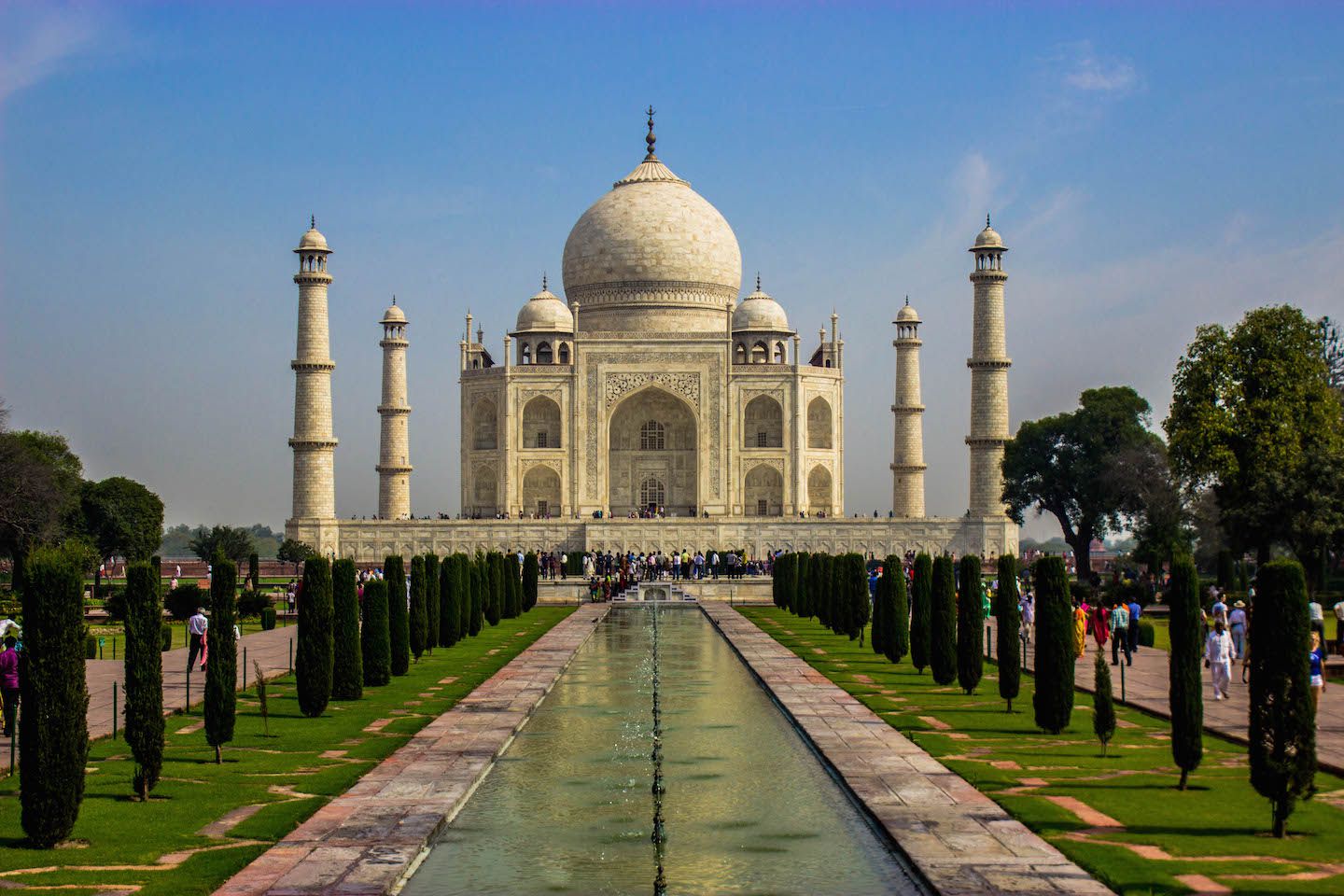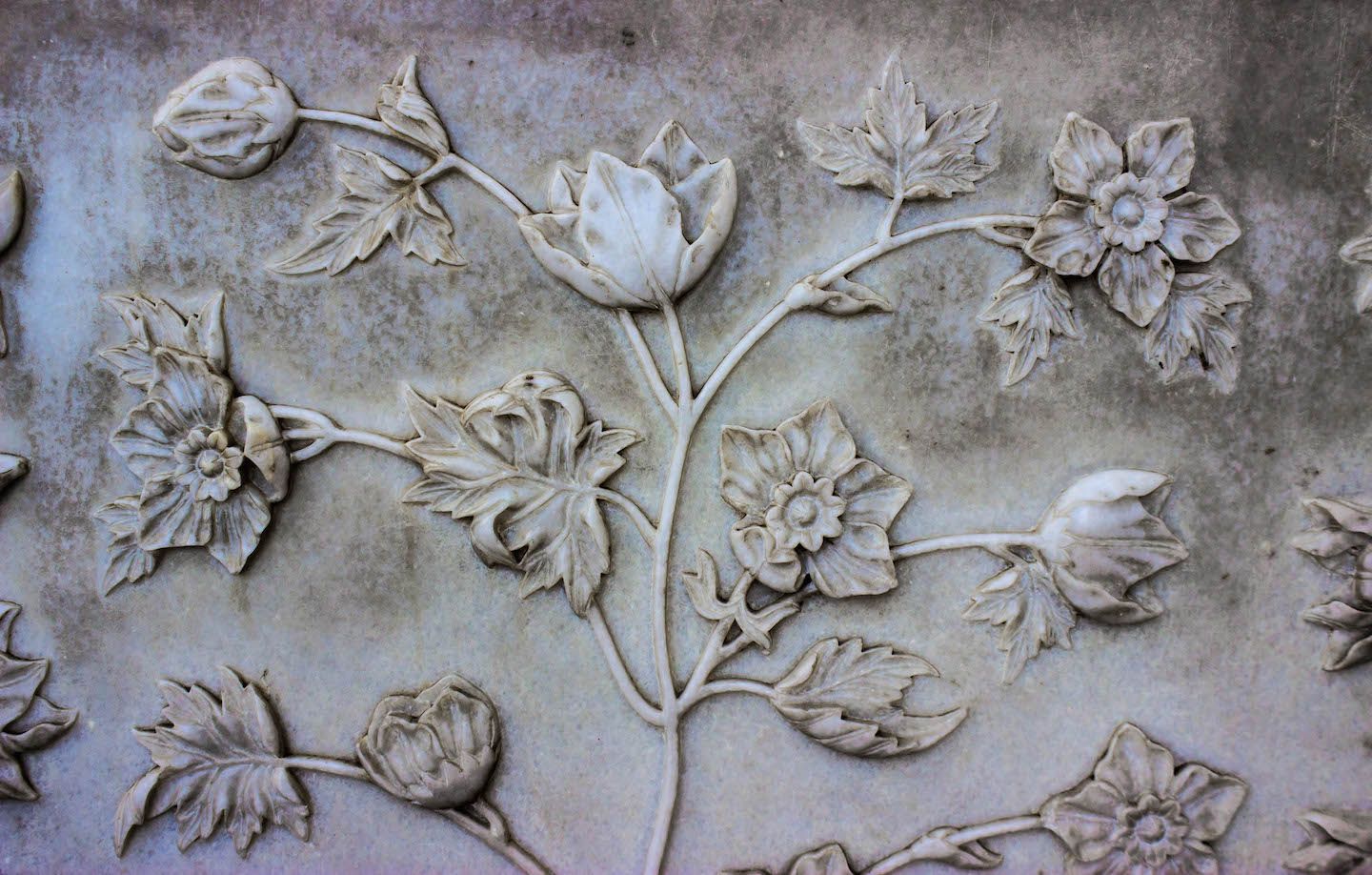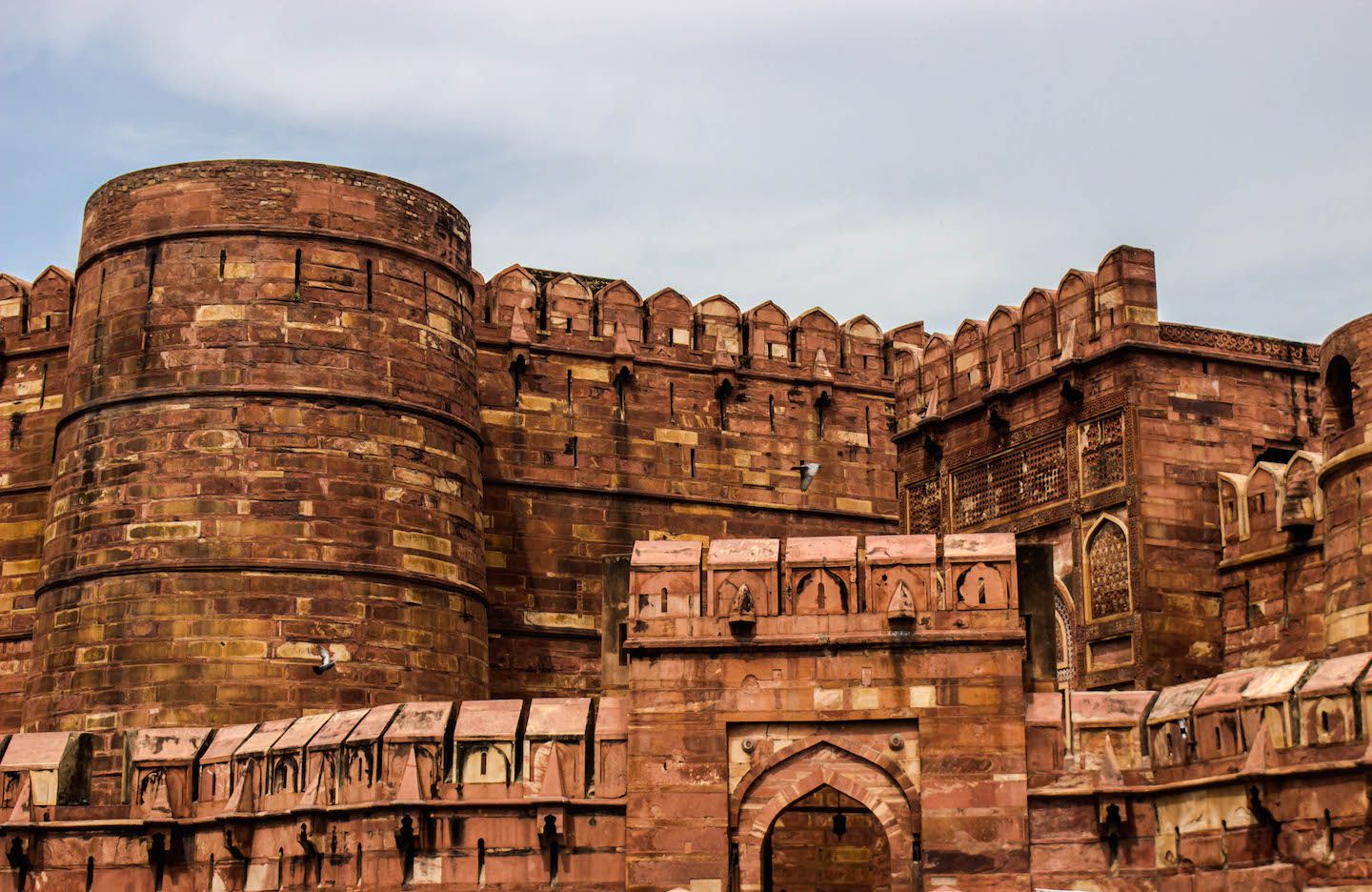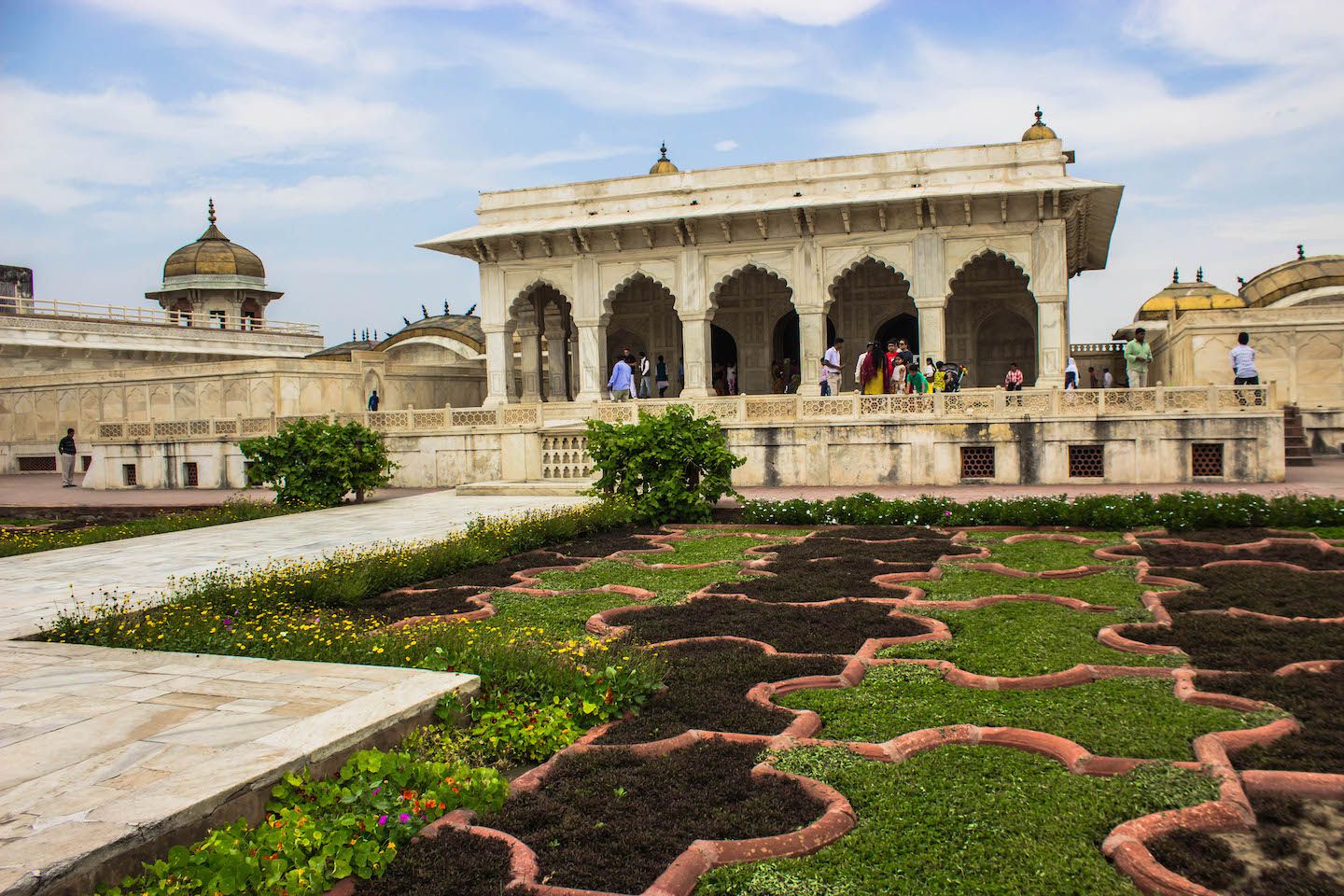In eighth grade, for a school project, I made a scaled 3D model of the Taj Mahal. I can’t remember the requirements for that project, but I do remember knowing instantly that I would choose this particular structure for its myriad of geometric shapes. I never thought at the time that I would get to visit the Taj Mahal in person! While my model had all the main components of the structure, it came nowhere near to capturing the majesty of the real thing.

We took just a day trip to Agra from New Delhi as we mainly wanted to see the Taj Mahal and Agra Fort. The day began very early on a 6am express train. The ride was surprisingly pleasant in AC chair seats, with breakfast even included (bread, omelette, tea, biscuits). In only two and a half hours, we were in Agra and on our way to the Taj Mahal!
Taj Mahal
Arguably the most iconic building in the entire country, no visit to India is complete without a visit to the Taj Mahal. I would say that it was one of my most-anticipated famous structures during this trip, second only after Angkor Wat. In retrospect, the anticipation was wholly deserved. We learned that it was so much more than just a white marble mausoleum.
The minute we entered the gates of the Taj Mahal area, it already felt like a special place. Security was tight and no food was allowed – we regrettably had to throw away all the snacks we brought with us, but I imagine it’s the only way to keep such a large area in India in impeccable order, especially with the sheer number of daily visitors. In lieu of a guide, we picked up audio guides that gave us the independence and flexibility that we preferred. Most people entered via the south gate; we came in from the west. All gates led to an open garden with large trees and a path to what we were all waiting for.

My first glimpses of Taj Mahal were unintentional. While examining the main entrance to the tomb, I saw it for a split second. Can it be? I forgot all about the calligraphy and motifs on the gateway entrance and couldn’t help but walk through it towards the framed mausoleum. In a few steps, we were hit with the full view. The first moments literally made me catch my breath. The Taj Mahal stood in the distance, white, ethereal, framed by a beautiful garden. It was exquisite.

Once you’ve seen it, it was hard to look away. I had seen pictures of the Taj Mahal a million times, but even the best ones did not do the real thing justice. Standing there in person, we had a sense of just how grand and magnificent Taj Mahal was. The pond and lines of trees and walkways led the eyes directly to the masterpiece. From up close, the structure was even more imposing, but yet still beguiling. The Taj Mahal was enchanting from every angle.

Besides its visually-pleasing exterior, what made the Taj Mahal so special was its story, meaning and significance. Mughal emperor Shah Jahan ordered its construction after his favourite wife and the love of his life, Mumtaz Mahal, died after giving birth to their fourteenth child. During their nineteen years together, they were inseparable, even during his travels and conquests. After her death, Shah Jahan was said to be extremely grief-stricken and inconsolable. The next year, building for the Taj Mahal began, as her final resting place (and his later on, as well). More than anything else, the Taj Mahal was a symbol of love.
Inspired by the Humayun’s Tomb and Jama Masjid in Delhi, the Taj Mahal is considered to be the epitome of Mughal architecture, with elements drawn from Indian, Persian, and Islamic styles. The simple symmetrical shapes of the white marble mausoleum reached a new level of refinement for the time of its construction. The many motifs and carvings on the exterior walls were abstract or flower oriented with interspersed verses of the Quran. Inside, the cenotaphs of Mumtaz Mahal and Shah Jahan dominated the main chamber (the original tombs are in the lower, closed level).

Four minarets built slightly outside the main platform framed the mausoleum. They were built outside of the platform so that in the case of a structural failure, the materials of the tower would fall away from the main structure. During its construction, a huge brick scaffolding was built around the Taj Mahal (instead of normal bamboo) and legends said that it would take years to dismantle. However, Shah Jahan offered the bricks of the scaffolding to anyone who would take it and the wall was dismantled overnight.
On either side of the main mausoleum, a mosque and a guesthouse stood in perfect symmetry. In contrast to the white marble of the Taj Mahal, these two flanking structures were built in typical red sandstone. To the back of the Taj Mahal, the Yamuna River gently turned and bathed the base of the mausoleum, blessing the whole area.

A world-famous monument for over 300 years, it was only natural that many rumors and myths have been told about the Taj Mahal. The most famous one being that Shah Jahan intended to build a black marble replica of the Taj Mahal on the other side of the river, which would serve as his grave. This was not true. Another myth claimed that various architects and craftsmen who worked on the tomb were tortured as well as forced to sign contracts that restricted them from working on similar designs. No evidence exists for this claim. While all of these were creative stories, they were nothing but myths.

For hours, we sat in every corner of the Taj Mahal and admired the views. We examined and admired its designs and details. We walked through the grounds and marveled at the execution of this world wonder. Being there really was surreal and magical. We both felt very lucky to have had this opportunity, because the experience and the pictures were priceless.
Agra Fort
In addition to the Taj Mahal, we visited its sister monument in Agra, the Agra Fort. Though similar to the Red Fort in New Delhi, it has been much better preserved and not as restored. While the fort was worth seeing, there was no denying that it was heavily overshadowed by the majestic Taj Mahal. Unfortunately, this was the reality for any other sights in Agra.

We still gave the fort as much enthusiasm as we could muster. There was no doubt the Agra Fort had incredible proportions with high walls over almost 100 acres of land. It wouldn’t be hard to get a bit lost in the courts, halls and gardens. We liked all the intricate and artistic carvings and motifs on the many walls and columns in the fort. As refuge from the unrelenting sun, our favourite times at Agra Fort were spent sitting in the galleries or by the windows. Some of them also gave us a nice view of the Taj Mahal in the distance.

We considered visiting Fatehpur Sikri, a city outside of Agra, but we were tired after an early start to a long day. The main goal was to visit the Taj Mahal, and we were more than happy with what we saw. We boarded the train back to New Delhi, still trying to let the fact that we just visited the Taj Mahal sink in. It was a nice day trip to Agra.
For more pictures from Agra, please visit the gallery!

